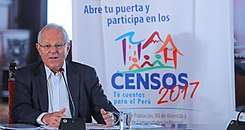2017 Peru Census
The 2017 Peru Census was a detailed enumeration and twelfth national population census of Peru. It was conducted by the Instituto Nacional de Estadística e Informática[3] on Sunday, October 22, 2017. Its full name in Spanish is XII Censo de Población, VII de Vivienda y III de Comunidades Indígenas. The previous census performed in Peru was the 2007 Census.
| Twelfth census of Peru | |
|---|---|
| General information | |
| Country | Peru |
| Date taken | October 22, 2017 |
| Total population | 31 800 000 [1][2] |
| Percent change | |
| Most populous region | Lima |
| Least populous region | Madre de Dios |
Questions
The census form had 47 questions referring to households and basic services, housing, methods of travel and formation of families; such as gender, disability and ethnicity.[4] A question on ethnic self-identification was included in the 2017 census.[5][6]
Results

Population
Comparison between the 2007 and 2017 census.
| Population by region[7] | |||||
|---|---|---|---|---|---|
| Region | Population 2007 |
Population 2017 |
Change | ||
| Lima | 8,442,409 | 9,485,405 | 1,042,996 | ||
| Piura | 1,676,315 | 1,856,809 | 180,494 | ||
| La Libertad | 1,617,050 | 1,778,080 | 161,030 | ||
| Arequipa | 1,152,303 | 1,382,730 | 230,427 | ||
| Cajamarca | 1,387,809 | 1,341,012 | −46,797 | ||
| Junín | 1,225,474 | 1,246,038 | 20,564 | ||
| Cusco | 1,171,403 | 1,205,527 | 34,124 | ||
| Lambayeque | 1,112,868 | 1,197,260 | 84,392 | ||
| Puno | 1,268,441 | 1,172,697 | −95,744 | ||
| Ancash | 1,063,459 | 1,083,519 | 20,060 | ||
| Callao | 879,679 | 994,494 | 114,815 | ||
| Loreto | 891,732 | 883,510 | −8,222 | ||
| Ica | 711,932 | 850,765 | 138,833 | ||
| San Martín | 728,808 | 813,381 | 84,573 | ||
| Huánuco | 762,223 | 721,047 | −41,176 | ||
| Ayacucho | 612,489 | 616,176 | 3,687 | ||
| Ucayali | 432,159 | 496,459 | 64,300 | ||
| Apurímac | 404,190 | 405,759 | 1,569 | ||
| Amazonas | 375,993 | 379,384 | 3,391 | ||
| Huancavelica | 454,797 | 347,639 | −107,158 | ||
| Tacna | 288,781 | 329,332 | 40,551 | ||
| Pasco | 280,449 | 254,065 | −26,384 | ||
| Tumbes | 200,306 | 224,863 | 24,557 | ||
| Moquegua | 161,533 | 174,863 | 13,330 | ||
| Madre de Dios | 109,555 | 141,070 | 31,515 | ||
| Peru | 27,412,157 | 29,381,884 | 1,969,727 | ||
Ethnic group and religion
Self-identified ethnicity
Responses are for the population of 12 years old and above.
| Ethnic group | Population | Percentage | |
|---|---|---|---|
| Mestizo | 13,965,254 | 60.2% | |
| Quechua | 5,176,809 | 22.3% | |
| White | 1,366,931 | 5.9% | |
| Afro-descendant | 828,841 | 3.6% | |
| Aymara | 548,292 | 2.4% | |
| Native or indigenous to the Amazon | 79,266 | 0.3% | |
| Asháninka | 55,489 | 0.2% | |
| Part of another Indigenous | 49,838 | 0.2% | |
| Aguaruna/Awajún | 37,690 | 0.2% | |
| Shipibo-Conibo/Konibo | 25,222 | 0.1% | |
| Japanese (Nikkei) | 22,534 | 0.1% | |
| Chinese (Tusan) | 14,307 | 0.1% | |
| Other | 254,892 | 1.1% | |
| Don’t know / no response | 771,026 | 3.3% | |
| Total | 23,196,391 | 100.0% | |
| Source:INEI[7] | |||
Religion
Distribution of religious denominations.[8]
| Religion | Population | Percentage | Change 2007-2017 | |
|---|---|---|---|---|
| Catholic | 17,635,339 | 76.0% | ||
| Evangelical | 3,264,819 | 14.1% | ||
| Total, other | 1,115,872 | 4.8% | ||
| Christian | 381,031 | 1.64% | - | |
| Adventists | 353,430 | 1.52% | - | |
| Jehovah's Witnesses | 173,602 | 0.75% | - | |
| Mormon | 113,659 | 0.49% | - | |
| Other | 94,150 | 0.41% | - | |
| No religion | 1,180,361 | 5.1% | ||
| Total | 23,196,391 | 100.0% | ||
See also
References
- "INEI realizará censos de población y vivienda en setiembre de este año". Andina. 27 January 2017. Retrieved 30 January 2017.
- El INEI estima que 31 millones 800 mil peruanos serán censados este domingo.
- "Mediante una aplicación, afroperuanos podrán participar en el Censo Virtual Afroperuano". La República. Archived from the original on 11 October 2015. Retrieved 1 September 2015.
- "Censo Nacional 2017: la orden de inamovilidad y otros detalles a tener en cuenta". El Comercio. 3 August 2017. Retrieved 3 August 2017.
- "Se instaló el Comité Técnico sobre Estadísticas Étnicas con participación de organizaciones indígenas y afroperuanas". cultura.gob.pe. Retrieved 1 September 2015.
- "INEI incluirá por primera vez dos preguntas de autoidentificación étnica en Censo 2017". Gestión. 23 November 2016. Archived from the original on 20 May 2017. Retrieved 15 May 2017.
- "Perú: Perfil Sociodemográfico" (PDF). Instituto Nacional de Estadística e Informática: 214. Cite journal requires
|journal=(help) - "Más de medio millón de peruanos se convirtieron en evangélicos durante los últimos 10 años". El Antídoto.pe. October 1, 2018. Archived from the original on November 19, 2018. Retrieved November 19, 2018.